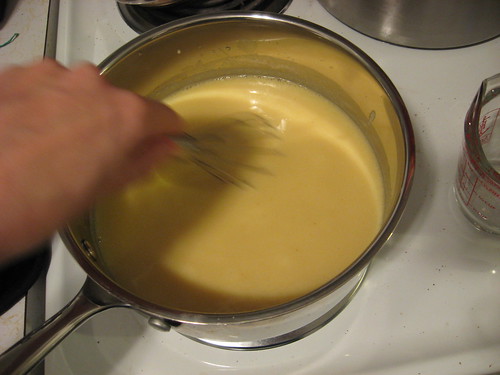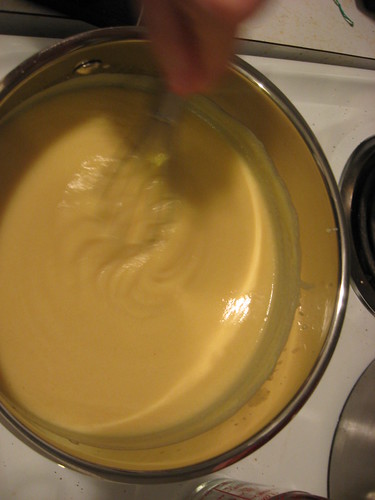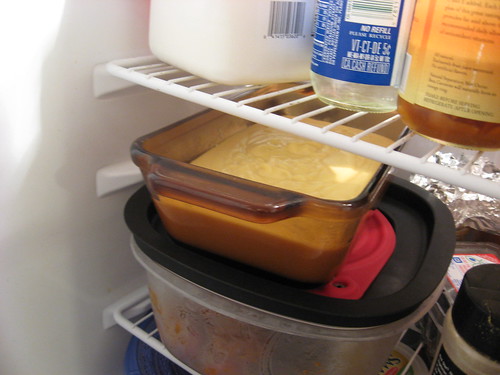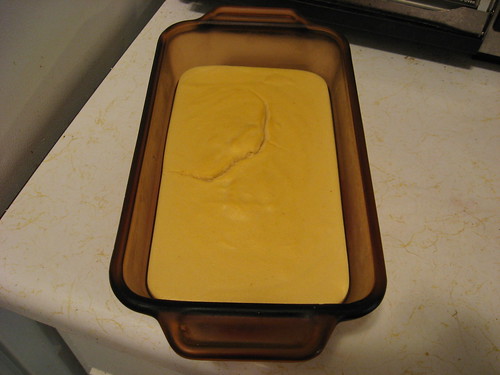Chickpea/Yellow Split Pea Flour version (1/2 recipe version)
1 ½ cup rice besan (chickpea) flour/yellow split pea flour
4 ½ cup water
Pinch ground turmeric
½ tsp vegetable oil
½ tsp salt
1 ½ cup rice besan (chickpea) flour/yellow split pea flour
4 ½ cup water
Pinch ground turmeric
½ tsp vegetable oil
½ tsp salt
Utensils
5 qt heavy bottomed pan
Wire whisk (preferably one with a rubber grip handle)
Container to hold rice flour and water while soaking, for ½ recipe at least 6 cups, for full recipe at least 12 cups
Loaf pan (this is what I use for ½ recipes, for a full recipe you will need at least a 12x3 pan)
Directions
1. Put the water and besan/yellow split pea flour into a container and stir till combined. Cover container and let sit for 12 hours.
1. Put the water and besan/yellow split pea flour into a container and stir till combined. Cover container and let sit for 12 hours.


2. After soaking, oil pan and mold for tofu. Pour mixture into pan, add turmeric and bring to a boil. Put on moderate heat and stir with a whisk or large spoon for the 15 minutes. The mixture needs to be kept in continuous motion or lumps will form.


3. Once the 15 minutes are up, pour in the sludge from the soaking container and stir over low heat for 5 minutes. The mixture will thicken quickly. Again keep the mixture in continuous motion to prevent lumps from forming.

4. At the end of the 5 minutes, pour the mixture into the mold and place in the refrigerator for 12 hours to set.

5 . When the tofu is set, slice and use as wish.


I'm determined to give this another try and get it to work, I have so much I want to do with this! Thanks for the tutorial :)
ReplyDeleteHmmm I wonder if I can get split pea flour here, I tend to have problems with chickpeas too :(
This looks great, thanks for the tutorial as well!
ReplyDeleteI'm so delighted by this I don't know how to act. This might just be my savior on the days when I'm soy-ed out. Thank you! :)
ReplyDeleteRachel & Kate, you are welcome.
ReplyDeleteVegetation, glad you are willing to try it again.
I tried it once and it worked however the taste was terrible, like it wasn't cooked or i don't know how to explain the taste and smell. However i didn't leave it soak overnight. would this make any different
ReplyDeleteAnonymous, don't know why the taste would be bad. I know that Vegetation (over at http://vegesveggiepatch.blogspot.com/2009/03/fun-with-food.html) says that the yellow split pea flour version smells horrible when making it, but doesn't taste that way.
ReplyDeleteAs for the soaking, I think that is so that flour is evenly moistened. It could also be that the soaking does something that we are not aware of occuring, since we are most likely using a westernization of the process they use in Burma. All I can say is to try again and see if the soaking changes it. However, make sure you are using either yellow split pea flour or chickpea flour. You could also just make a half batch, just in case you are worried with wasteing supplies.
Thank you. I'll try it again tonight and let you guys know tomorrow. You know this is my forever favourite food. but i like it with noodle when it'll still warm. have you had the warm, liquidy version?
ReplyDeleteHaven't tried the warm version, Anonymous, but I do know that is a common way to eat it in Burma. Might have to try it sometime.
ReplyDeletei feel stupid, but i am confused as to what you pour in first (to mix & heat) and what you pour in afterwards. is it just the two different layers of the soaking mixture?
ReplyDeletehannah, I guess you could look at it that way. What you are doing in the first 15 minutes is reducing the mostly liquid portion of the chickpea flour and water, as well as cooking some of the chickpea flour. The sludge at the bottom, which is mostly chickpea flour, is used to thicken the entire mixture. It should be mostly flour, and very little liquid. Think of the sludge as the stuff that does not easily pour out of the container when you first pour the mixture into the pan.
ReplyDeleteDoes any of that help?
Any recipe ideas? Came out good, just wonder if I should use it like normal tofu or if you had some good ideas?
ReplyDeleteAnonymous, this doesn't work like normal tofu. However, it will work in stir fries, just cook it before you add any sauces. It will also work in scrambles apparently, though I have not had much success in that. You can't marinate it, which is a major shortcoming. If you click the Burmese Tofu link under Labels, you can see what I have done.
ReplyDeletethank you, I made a quick scramble with it and onion and garlic and it came out good, gets a little mushy but not in a bad way. I checked out the other ways you have made it and look forward to trying some of those.
ReplyDeleteShawn
Is the tumeric for color? Can it be omitted?
ReplyDeleteAnonymous, don't know why they add the tumeric. It can't be for color, since the chickpea flour is yellow anyway. It may be for flavor. You can omit it, but I don't know if it will affect the taste.
ReplyDeleteThanks about the tumeric. Have you tried making tofu from other kinds of beans with this technique? Seems like it could work for a variety of beans.
ReplyDeleteDo you know why they go through all of this trouble? Why not just cook the flour like polenta and let it set in the fridge. The Italians have a similar thing called panelle where it is cooked polenta style, let to cool, sliced then fried. Does the Burmese way remove something that makes it healthier or tastier? Thanks for the post. http://en.wikipedia.org/wiki/Panelle
ReplyDeleteAcutally, if you think about it Anonymous, this is very polenta like, just made with chickpea flour instead of cornmeal. You could say they are using what they have available to them. Also in Burma, this is made with chickpeas that have been soaked, ground then cooked. The flour is just a shortcut for us.
ReplyDeleteWhat I meant was why do all the Burmese tofu recipes say soak it over night then skim off top then drain sludge then remove some liquid and so forth when the Sicilians just take chickpea flour and immediately stir it into simmering water, cook it the way one would make polenta, pour it in a mold and let it set for panelle. Just curious if someone knows if there is some health or taste reason for all of these extra steps instead of doing it the Sicilian way. Thanks for replying last time.
ReplyDeleteDon't know, but if you have noticed I do skip the the skimming step. As for the sludge, it is used to thicken the batch, after you have reduced the water a bit more. I suppose you could make it the way one makes polenta, but the texture may be different.
ReplyDeleteMy Grandmother is from Burma, and she always taught me to toast tumeric in oil before ever adding water to it (in pretty much everything), this is to get rid of the 'raw' smell aparently. I assume the tumeric is added to this for the same reason seeing as its virtually tasteless. I'm in the process of giving this a whirl now, can't wait to see what its like seeing as regular tofu here is bloody expensive!
ReplyDeleteYou should post this recipe on VegWeb, seriously, "Chick-Fu" stuff sounds crazy
ReplyDeleteHello there
ReplyDeletethis is an old post so I hope snuggle bunny doesn't mind answering questions.
I'm so happy to find this recipe ... as I avoid tofu and soy milk ... and as a vegan - I desperately want to make tofu from other materials!
I have a question about the ingrediants....
It says
"1 ½ cup rice besan (chickpea) flour/yellow split pea flour"
what does that mean???
is that a combination of rice flour and chickpea flour and yellow split pea flour?
if so
do you know the amounts of each?
(I make / grind my own flour)
thank you so much for a wonderful post!
It means that you can use either chickpea flour or yellow split pea flour. I use chickpea flour, since that is all I can find in the store.
ReplyDeleteAnd sorry for the delay in replying. Blogger wouldn't let me log in for some reason.
I am definitely going to try this as a vegan mom of a child with a soy allergy. We eat a lot of beans and seitan, and if I can get this to work, we can have some more protein possibilities!
ReplyDeleteI will be so happy to try this with white bean flour. I'm an adult allergic to soy and many, many legumes. I have been a meat eater, though I'm very disturbed by how food animals are treated. Something like this opens up a whole new window of possibilities for me. Thanks for your step by step.
ReplyDeleteThanks for the recipe! I am trying it out tonight, I am on step one of soaking. I remember eating awesome burmese tofu salad, fried tofu and this spectacular fried rice with a spicy garlic chutney at my Burmese friend's place a few years ago. Do you have recommendations to the burmese rice and curry (vegetarian) recipes? Thank you so much!
ReplyDeletePkDomain is one of the most affordable and best hosting company in Pakistan which provides various cheap hosting packages for your needs which includes VPS hosting, cloud hosting, reseller hosting, dedicated hosting with a great deal of monthly bandwidth, data storage and email services. Buy cheap domain hosting from www.pkdomain.com.pk. We guarantee 99.98 % uptime; cloud data center and leave no stone upturned in meeting your expectations.
ReplyDeleteThank You and that i have a swell supply: Can You Hire Someone To Renovate A House home addition builders near me
ReplyDelete